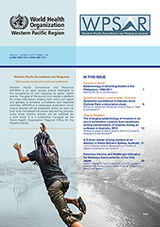A Q fever cluster among workers at an abattoir in south-western Sydney, Australia, 2015
DOI:
https://doi.org/10.5365/wpsar.2016.7.2.012Abstract
Background: In September 2015, the Public Health Unit of the South Western Sydney Local Health District was notified of two possible Q fever cases. Case investigation identified that both cases were employed at an abattoir, and both cases advised that co-workers had experienced similar symptoms. Public Health Unit staff also recalled interviewing in late 2014 at least one other Q fever case who worked at the same abattoir. This prompted an outbreak investigation.
Methods: The investigation incorporated active case finding, microbiological analysis, field investigation and a risk factor survey. Included cases were laboratory definitive or suspected cases occurring from October 2014 to October 2015, residing or working in south-western Sydney. A suspected case had clinically compatible illness, high-risk exposure and was epidemiologically linked to another confirmed case. A confirmed case included laboratory detection of C. burnetti.
Results: Eight cases met the case definition with seven confirmed (including a deceased case) and one suspected. The eight cases were all males who had been employed at an abattoir in south-western Sydney during their incubation period; symptom onset dates ranged from November 2014 to September 2015. Field investigation identified multiple potential risk factors at the abattoir, and the majority (75%) of employees were not vaccinated against Q fever despite this high-risk setting.
Conclusion: This cluster of Q fever in a single abattoir confirms the significance of this zoonotic disease as an occupational hazard among persons working in high-risk environments. Implementation of Q fever vaccination programmes should eliminate Q fever in high-risk occupational settings.

